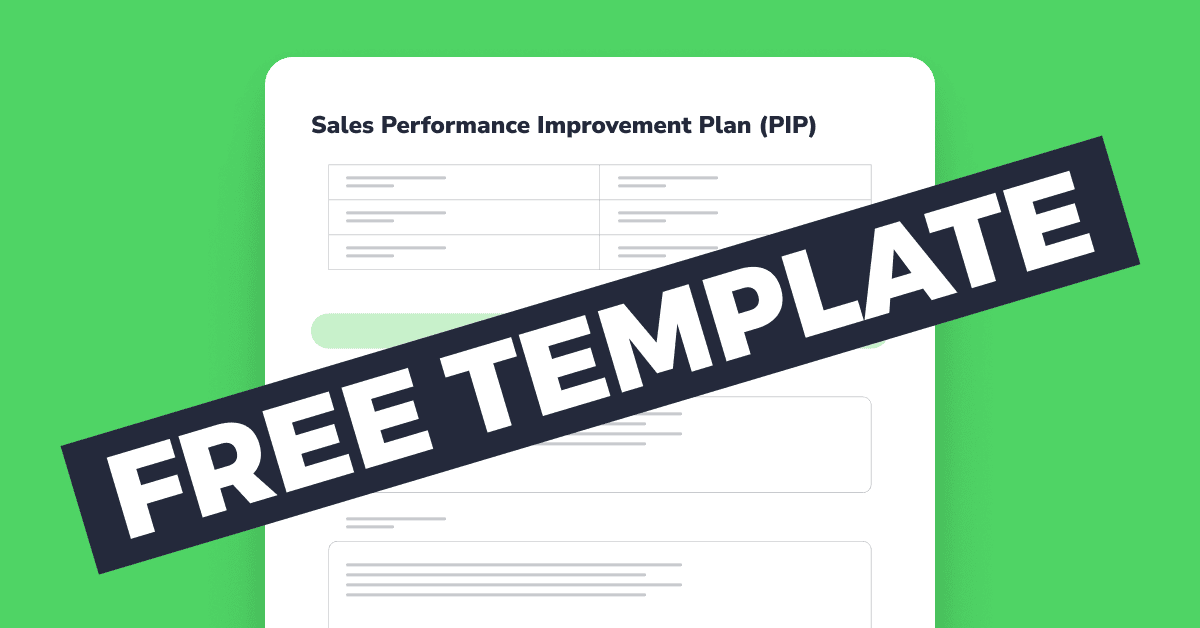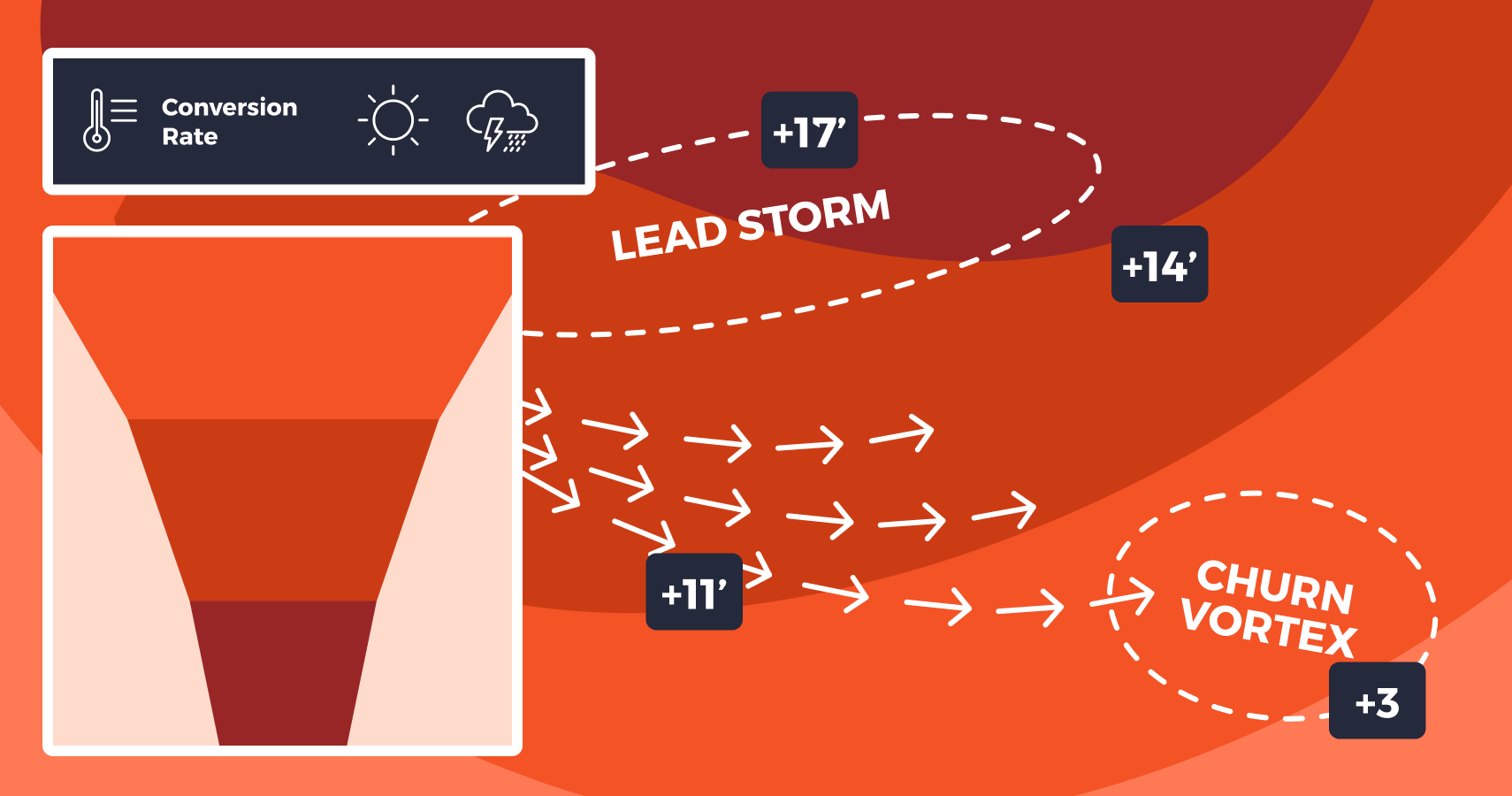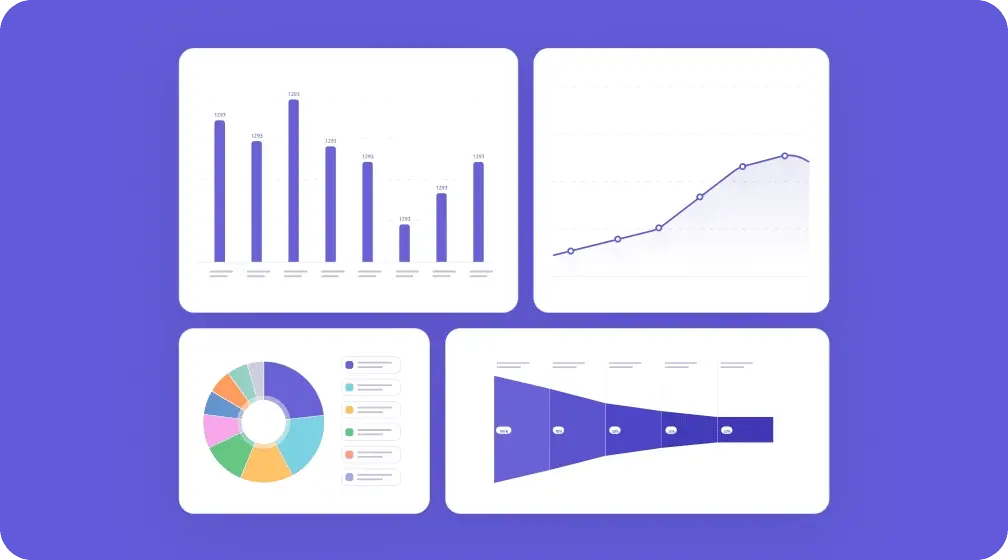How to Create a Sales Performance Improvement Plan in 7 Steps [+FREE TEMPLATE]

Table of Contents:
- Step #1 Identify and address specific performance gaps in your sales team
- Step #2 Set clear, achievable goals
- Step #3 Create a fair performance improvement plan
- Step #4 Implement the plan and offer continuous support
- Step #5 Track and measure sales performance improvements objectively
- Step #6 Run productive coaching conversations
- Step #7 Decide on retention or termination based on clear metrics
- Sales Performance Improvement Plan – free template
- Conclusion
Performance Improvement Plans (PIPs) are often seen as a last resort – but they don’t necessarily have to. When done right, they’re not about letting someone go; they’re about giving them the support, skills, and direction they need to get back on track.
The key is making the PIP fair, transparent, and genuinely useful.
In this article, I discuss the steps you should take to create and execute your sales performance improvement plan. I also share a free template you can use to offer your underperforming team members a hand and help them succeed in the long-term.
Table of Contents:
Step #1 Identify and address specific performance gaps in your sales team
Step #2 Set clear, achievable goals
Step #3 Create a fair performance improvement plan
Step #4 Implement the plan and offer continuous support
Step #5 Track and measure sales performance improvements objectively
Step #6 Run productive coaching conversations
Step #7 Decide on retention or termination based on clear metrics
Sales Performance Improvement Plan – free template
Step #1 Identify and address specific performance gaps in your sales team
If you want to improve sales performance, the first step is digging into the numbers – conversion rates, deal size, and quota attainment.
Let’s say a salesperson books tons of meetings but barely closes any deals. That’s a sign they might need help with negotiation or handling objections. Comparing their performance with top reps can give you clues about what’s missing.
Listening to sales calls and getting feedback from customers and colleagues can also uncover problem areas. If a rep keeps losing prospects when it comes to pricing, they might not be showing enough value.
For example, if a customer says, “This is too expensive,” and the salesperson just replies, “That’s our price,” without explaining ROI, they’re missing an opportunity. A little training can go a long way here.
It’s also important to figure out why someone is struggling. Sometimes, it’s not a lack of skill, but a lack of confidence. If a representative hesitates to ask for the sale, role-playing can help. Practicing responses like, “I understand your concern, but many clients have actually saved [specific amount] over time with our solution,” can make them feel more comfortable and persuasive.
Sales managers can use Livespace to track key metrics like close rates, deal value, and follow-up efficiency. With this data, they can set clear, realistic goals. For example, increasing a rep’s close rate from 15% to 20% or speeding up their follow-up times. This way, improvements become measurable and actionable.
Step #2 Set clear, achievable goals
Setting clear and realistic goals helps sales reps stay focused and motivated. As their manager, you need to make sure that the individual targets you set in the PIP support team-level objectives.
Make them very specific. Instead of a vague aim like “sell more,” define concrete outcomes.
To cite a great piece from Workweek, “if people don’t know what’s expected of them and they fall short of their manager’s expectations, that’s the manager’s fault.”
For example, if someone struggles with successfully closing deals, a solid goal could be “increase sales win rate from 15% to 20% within three months.”
Goals should be ambitious but attainable. If a sales team member usually closes five deals a month, expecting them to suddenly hit 20 while on the PIP will only lead to frustration. A smarter approach is to gradually raise expectations while offering your support.
This brings me to setting the timeline. Instead of a goal of “get better at follow-ups,” you should go with a clear: “send follow-up emails within 24 hours and book at least two second meetings per week.”
If you don’t want to check in with the person all the time, you can track this time-bound progress easily in your CRM reports.
Last but not least, don’t forget to celebrate small wins. Whether it’s landing a tough meeting or improving response rates, they’re what will keep your employee invested during the performance improvement plan duration.
Step #3 Create a fair performance improvement plan
At this step, I believe we should address the “elephant in the room”, i.e., the fact that improvement plans often get bad press. Some people believe that a PIP is “a polite way of walking you to the door.”
On the one hand, some companies might use them to justify termination, rather than helping struggling sales team members improve their ability to meet objectives. On the other, I’ve often seen employees who were placed on a PIP successfully turn things around and continue thriving at the company. The key is a plan to be fair.
A “fair” plan can mean different things depending on your sales process and team structure. First and foremost, for a PIP to be truly “fair,” it should not hinder access to the resources an employee needs to improve their performance. If the plan restricts access to key data or if a manager starts prioritizing non-PIP employees over those under the plan, it’s clear that the employee won’t be able to succeed.
A PIP should help the employee, for example, by connecting them with senior or top-performing sales agents who can offer guidance. Or, by scheduling daily status meetings with the team leader to provide ongoing support.
Ultimately, as one Redditor shared, they had been placed on several PIPs throughout their career, and most resulted in them staying with the company. “In my experience, most managers want you to succeed because they depend on your performance too,” they concluded.
So, what should you look for when drafting a performance improvement plan?
Here are the main points:
- Clear performance expectations: define the sales quota the rep is expected to meet, along with specific improvement benchmarks (e.g., reaching 80% of the quota in month 1, 100% by month 2). Also, outline any additional sales KPIs, such as the required number of calls, emails, or demos completed per week.Note: As the PIP progresses, monitor performance through CRM reports and manager evaluations. Livespace’s reporting tools provide the precise metrics needed for PIPs, while task management features allow for tracking of improvement activities. This transforms the PIP framework from a theoretical concept into a practical, data-driven coaching tool, making the process more objective and effective.
- Duration & checkpoints: determine a specific timeframe (for example, 60 or 90 days). Then, agree on the frequency of check-ins with the sales manager. I recommend scheduling them weekly or biweekly to review progress.
- Actionable steps for improvement: define what you expect the employee to deliver.Depending on your business, these could be:
-
- Participating in sales training sessions focused on areas like objection handling and closing techniques.
- Shadowing top-performing sales reps.
- Improving lead qualification to focus on high-intent prospects.
- Adjusting outreach tactics (e.g., running more follow-ups or using personalized messaging).
- List of available resources & support: specify the exact resources the employee under the PIP will have. These should include access to coaching and/or mentorship, as well as necessary tools. It’s important that they have access to CRM data so they can track and manage leads better.
- Next steps:
- If the salesperson meets the targets, they will be removed from the PIP.
- If there’s some progress but not full quota achievement, the company may extend the PIP.
- If the person fails to meet the agreed-upon targets, termination may be the next step.
Step #4 Implement the plan and offer continuous support
Once the PIP is in motion, stay involved in your employee’s progress.
Even if they don’t directly request your help, make it clear that you’re there to support them. During check-ins, review any performance data from the CRM that may suggest they’re struggling and address it proactively.
You might suggest additional training or share valuable resources. For example, if they’re struggling with time to close deals, you could recommend our webinar with Bryan Murly of MySalesCoach on accelerating deal closures.
Keep in mind that the PIP itself can be a stressful situation, which might affect the employee’s learning pace. The average person retains only about 21% of information after 30 days. So, when offering opportunities for upskilling, encourage the sales rep to take a step-by-step approach and apply what they’ve learned in practice. This will help them maximize your support while easing any pressure they may feel.
Step #5 Track and measure sales performance improvements objectively
Many PIPs fail not because of lack of good will, but because they lack objective measurement tools and consistent tracking mechanisms. This is precisely what a good CRM system like Livespace provides.
Livespace makes it easy to track performance and spot issues early with detailed analytics. It helps document progress objectively and measure improvements accurately. This helps you clearly define what’s expected at each stage of the improvement plan, making it easier for those under a PIP to complete specific goals.
This turns the PIP process from potentially abstract (if based on vague objectives) into a practical, data-driven coaching tool.
Step #6 Run productive coaching conversations
In addition to having the right tools, it’s crucial to have productive coaching conversations with underperforming team members to support their growth. Approach these discussions with empathy, focusing on actions.
I recommend beginning with recognizing the employee’s efforts and strengths, and then discussing areas for improvement with specific examples.
Whether you’re the person’s direct manager or part of the HR team, create an open space for dialogue so that the employee can express their challenges and suggest ways to improve. This communicates to the sales rep that it’s a two-way conversation, where both perspectives are taken into account. By keeping the conversation supportive and solution-focused, you help the rep make feel more invested in their growth and, ultimately, dedication to stay at the company.
Step #7 Decide on retention or termination based on clear metrics
Making decisions about retention or parting ways with an employee should always be based on clear, objective metrics. Continuously track the employee’s performance, focusing on metrics like quota attainment, to get a comprehensive view of their progress.
If you’re unsure whether their progress is sufficient, data from tools like Livespace can offer the clarity you need. They’ll help you assess whether they’ve made real improvements or if it’s time to explore other options.
By relying on concrete insights, you make sure that your decisions are fair and aligned with the team’s overall goals. This approach eliminates any risk of bias or favoritism, ensuring a transparent and objective process.
I recommend asking yourself the following questions, categorized into key performance areas:
Performance trends in the CRM
- Has the employee improved in key areas such as deal closing rate, pipeline management, or client engagement?
- Is there an upward trend in sales numbers, or is performance stagnating?
Effort & attitude
- Are they actively implementing feedback and using the provided resources?
- Are they showing motivation and willingness to improve?
External factors
- Is the underperformance due to external factors (e.g., a weak market, poor lead quality) rather than the person’s skills?
Impact on team & business
- Is the sales rep’s low performance affecting team morale or creating bottlenecks?
- Can the company afford to retain them given their contribution to revenue?
Alternative roles
- Would the team member be better suited for a different role, such as customer success or business development?
Sales Performance Improvement Plan – free template
Need a sales performance improvement plan? We’ve got a ready-to-use template for you.
Just leave your email and we will send it directly to your inbox.
Conclusion
A performance improvement plan (PIP) can be a game-changer when it comes to helping your sales team get back on track.
You should start off by pinpointing exactly where team members are struggling, so you can focus on the areas that need attention. From there, create a fair and structured plan that gives them clear goals and the support they need to improve.
It’s crucial to track progress with measurable, objective metrics, so you can see if they’re really moving in the right direction. Along the way, have regular, productive coaching conversations to offer guidance and keep motivation high.
Ultimately, you want to be able to make informed decisions about whether to keep or let go of team members, based on objective, performance-driven insights.
If you need help getting started with a PIP, check out the template I’ve provided in this article to guide you through the process.
Other posts

The Beginner’s Guide to Sales Forecasting (For Sales Directors & Managers)

How to shorten the sales cycle in 9 easy steps







![[alt] Sales Performance Improvement Plan; use a CRM with advanced reporting to track your employee’s progress](https://www.livespace.io/wp-content/uploads/2025/04/image1-1.png)
![[alt] sales performance improvement plan; Livespace lets you track progress in real-time](https://www.livespace.io/wp-content/uploads/2025/04/image2.png)